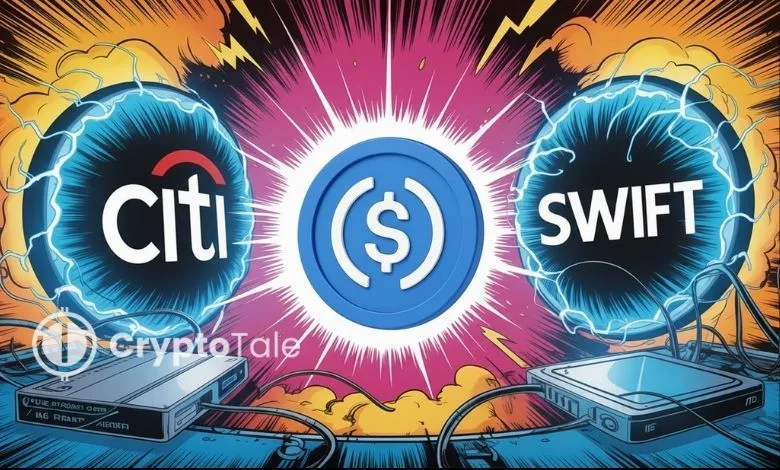Citi Completes Fiat to Digital Settlement Trial With Swift

- Citi–Swift pilot enables synchronized fiat–stablecoin PvP settlement through hybrid modes.
- Workflow links bank systems with blockchain layers using escrow and coordinated messaging.
- Trial shows stablecoins as practical bridges within emerging regulated settlement flows.
Citibank and Swift completed a Payment-versus-Payment settlement pilot between fiat and digital currencies in a coordinated technical trial conducted through Swift’s global network. It involved Citi, Swift, and Circle’s test of USDC on Ethereum Sepolia, aiming to enable synchronized settlement while addressing cross-border risk and infrastructure gaps. The trial happened to show how banks now align blockchain tools with existing fiat systems.
Hybrid Settlement Framework
Citi and Swift jointly tested a workflow that connected traditional bank infrastructure with distributed ledger transaction layers through enhanced messaging coordination. However, the pilot did not replace existing modes; instead, it extended them through controlled blockchain interoperability mechanisms. The process relied on Swift’s infrastructure, while Citi integrated blockchain connectors, orchestrators, and smart contracts.
The trial used test USDC tokens issued by Circle to simulate a near-production environment on Ethereum Sepolia. However, the workflow did not execute as an atomic transaction due to dual system dependence. The structure instead synchronized payment legs to ensure both currency flows settled together.
Therefore, the trial showed the gradual positioning of blockchain as an extension of bank settlement operations. The design showed that regulated stablecoins now function as a practical bridge asset within institutional settlement exploration. This aligned with the pilot’s core objective of reducing counterparty exposure.
Stablecoins Support Real-Time Interoperability
According to Citi GPS, stablecoin issuance could reach USD1.9 trillion by 2030 as regulatory clarity expands and use cases grow. However, recipients still convert most stablecoin settlements into local fiat currencies after receipt. This trend shows the need for reliable fiat and digital settlements together.
Citi and Swift structured a new messaging standard to track transactions from initiation through confirmation. The system recognized the separate data fields inherent in both fiat and digital currency flows. This ensured complete end-to-end settlement visibility during the trial.
However, the challenge is that blockchain payments are irreversible, while bank transfers can be reversed under controlled conditions. Therefore, the pilot integrated an escrow mechanism to manage timing differences and reduce exposure risks. A central orchestrator coordinated message sequences and ensured synchronized settlement events.
Jonathan Ehrenfeld, Head of Strategy at Swift, stated that Swift can serve as a single trusted access point between tokenized systems and global banks. Ayesa Latif, Citi Head of FX Products, stated that the project advanced cross-border settlement speed and risk controls. Their statements support the pilot’s structural objective.
Infrastructure Adjustments and Strategic Realignment
Citi also aligned this initiative with its broader tokenized deposit infrastructure, including Citi Token Services. The bank previously linked these services with its 24/7 USD Clearing network for continuous fund movement. However, partner banks must onboard to Citi Token Services to participate.
Citi recently joined a consortium of ten systemically important banks supporting stablecoin payments. This effort connects to the institution’s wider focus on regulated digital settlement layers. The pilot with Swift expanded that same vision through direct interoperability testing.
The messaging adjustments used within the trial built on FX standards such as MT30X. However, those standards alone cannot coordinate fiat and digital settlement timing. Therefore, the new structure introduced customized data sequencing for real-time currency alignment.
Swift continues developing its own ledger while strengthening orchestration between hybrid settlement environments. The collaboration showed Swift’s strategy to bridge legacy infrastructure with blockchain-based value systems. This approach directly supports interoperability without structural disruption.
Related: Wall Street Giant Citi Plans Native Crypto Asset Custody by 2026
Swift led transaction coordination while Citi executed settlement workflows using secured blockchain connectors. Both payment legs reached synchronized completion without settlement exposure. The model focused on synchronized timing and structured confirmation workflows.
The test environment included USDC movement across Ethereum Sepolia to show controlled operational conditions. Citi verified payment execution timing through its orchestrated transaction flow design. This testing model allows a realistic simulation without systemic market exposure.
The pilot also addressed common fragmentation issues within cross-border digital finance. These issues include compatibility barriers between blockchain wallets and correspondent banking accounts. The framework introduced clear procedures that closed these operational gaps.
Through this process, Citi and Swift established early foundations for hybrid fiat and tokenized settlement operations. The pilot supported real-time coordination without abandoning existing banking controls. This ensured alignment with regulatory standards and structured transaction oversight.
Meanwhile, the Citi and Swift pilot confirmed operational feasibility for hybrid fiat and digital PvP settlement structures. The trial used stablecoin test assets, coordinated messaging, and escrow controls to maintain synchronized settlement integrity. Together, both institutions demonstrated measured integration of blockchain within traditional banking workflows.





